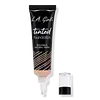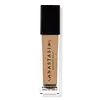What's inside
What's inside
 Key Ingredients
Key Ingredients

 Benefits
Benefits

 Concerns
Concerns

 Ingredients Side-by-side
Ingredients Side-by-side

Water
Skin ConditioningCyclopentasiloxane
EmollientEthylhexyl Stearate
EmollientIsododecane
EmollientDiisostearyl Malate
EmollientTrimethylsiloxysilicate
EmollientSilica
AbrasiveGlycerin
HumectantEthylhexyl Palmitate
EmollientLauryl PEG-10 Tris(Trimethylsiloxy)Silylethyl Dimethicone
EmulsifyingQuaternium-90 Bentonite
Bis-Isobutyl PEG/PPG-10/7/Dimethicone Copolymer
EmulsifyingSodium Chloride
MaskingPolysilicone-11
Phenoxyethanol
PreservativePropylene Carbonate
SolventTocopheryl Acetate
AntioxidantEthylhexylglycerin
Skin ConditioningPanthenol
Skin ConditioningCarthamus Tinctorius Seed Oil
MaskingMethicone
EmollientLecithin
EmollientPolyhydroxystearic Acid
EmulsifyingPanax Ginseng Root Extract
EmollientPentaerythrityl Tetra-Di-T-Butyl Hydroxyhydrocinnamate
AntioxidantIsopropyl Myristate
EmollientIsostearic Acid
CleansingPolyglyceryl-3 Polyricinoleate
EmulsifyingLaureth-12
EmulsifyingCI 77891
Cosmetic ColorantIron Oxides
Water, Cyclopentasiloxane, Ethylhexyl Stearate, Isododecane, Diisostearyl Malate, Trimethylsiloxysilicate, Silica, Glycerin, Ethylhexyl Palmitate, Lauryl PEG-10 Tris(Trimethylsiloxy)Silylethyl Dimethicone, Quaternium-90 Bentonite, Bis-Isobutyl PEG/PPG-10/7/Dimethicone Copolymer, Sodium Chloride, Polysilicone-11, Phenoxyethanol, Propylene Carbonate, Tocopheryl Acetate, Ethylhexylglycerin, Panthenol, Carthamus Tinctorius Seed Oil, Methicone, Lecithin, Polyhydroxystearic Acid, Panax Ginseng Root Extract, Pentaerythrityl Tetra-Di-T-Butyl Hydroxyhydrocinnamate, Isopropyl Myristate, Isostearic Acid, Polyglyceryl-3 Polyricinoleate, Laureth-12, CI 77891, Iron Oxides
Water
Skin ConditioningCyclopentasiloxane
EmollientIsododecane
EmollientCaprylyl Methicone
Skin ConditioningC12-15 Alkyl Benzoate
AntimicrobialEthylhexyl Palmitate
EmollientPolyglyceryl-4 Isostearate
EmulsifyingHexyl Laurate
EmollientCetyl PEG/PPG-10/1 Dimethicone
EmulsifyingGlycerin
HumectantTrimethylsiloxysilicate
EmollientButylene Glycol
HumectantVinyl Dimethicone/Methicone Silsesquioxane Crosspolymer
Sodium Chloride
MaskingLaminaria Ochroleuca Extract
Skin ConditioningAlanine
MaskingArginine
MaskingGlycine
BufferingIsoleucine
Skin ConditioningHistidine
HumectantPhenylalanine
MaskingProline
Skin ConditioningThreonine
Serine
MaskingAspartic Acid
MaskingValine
MaskingSodium PCA
HumectantPanthenol
Skin ConditioningTocopheryl Acetate
AntioxidantAllantoin
Skin ConditioningSodium Lactate
BufferingPCA
HumectantEthylhexylglycerin
Skin ConditioningCaprylic/Capric Triglyceride
MaskingSimethicone
EmollientTetrasodium EDTA
Triethoxycaprylylsilane
Zinc Stearate
Cosmetic ColorantLauryl PEG-9 Polydimethylsiloxyethyl Dimethicone
Skin ConditioningStearalkonium Hectorite
Gel FormingPropylene Carbonate
SolventPhenoxyethanol
PreservativeChromium Oxide Greens
CI 77007
Cosmetic ColorantIron Oxides
CI 77891
Cosmetic ColorantWater, Cyclopentasiloxane, Isododecane, Caprylyl Methicone, C12-15 Alkyl Benzoate, Ethylhexyl Palmitate, Polyglyceryl-4 Isostearate, Hexyl Laurate, Cetyl PEG/PPG-10/1 Dimethicone, Glycerin, Trimethylsiloxysilicate, Butylene Glycol, Vinyl Dimethicone/Methicone Silsesquioxane Crosspolymer, Sodium Chloride, Laminaria Ochroleuca Extract, Alanine, Arginine, Glycine, Isoleucine, Histidine, Phenylalanine, Proline, Threonine, Serine, Aspartic Acid, Valine, Sodium PCA, Panthenol, Tocopheryl Acetate, Allantoin, Sodium Lactate, PCA, Ethylhexylglycerin, Caprylic/Capric Triglyceride, Simethicone, Tetrasodium EDTA, Triethoxycaprylylsilane, Zinc Stearate, Lauryl PEG-9 Polydimethylsiloxyethyl Dimethicone, Stearalkonium Hectorite, Propylene Carbonate, Phenoxyethanol, Chromium Oxide Greens, CI 77007, Iron Oxides, CI 77891
 Reviews
Reviews

Ingredients Explained
These ingredients are found in both products.
Ingredients higher up in an ingredient list are typically present in a larger amount.
Ci 77891 is a white pigment from Titanium dioxide. It is naturally found in minerals such as rutile and ilmenite.
It's main function is to add a white color to cosmetics. It can also be mixed with other colors to create different shades.
Ci 77891 is commonly found in sunscreens due to its ability to block UV rays.
Learn more about CI 77891Cyclopentasiloxane, or D5, is a silicone used to improve texture of products and trap moisture.
D5 is considered lightweight and volatile. Volatile means it evaporates quickly after application. Once evaporated, D5 leaves a thin barrier that helps keep skin hydrated.
It is also an emollient. Emollients help soften the skin and prevent water loss. Silicones create a silky texture in products. D5 helps other ingredients become more spreadable.
Studies show D5 is safe to use in skincare products. We recommend speaking with a skincare professional if you have concerns.
Learn more about CyclopentasiloxaneEthylhexyl Palmitate, also known as octyl palmitate, is created from 2-ethylhexyl alcohol and palmitic acid. It is a fatty acid ester.
The fatty acid content of Ethylhexyl Palmitate makes it an emollient. Emollients help soften and hydrate your skin by trapping moisture within.
Ethylhexyl Palmitate is also used to help improve the texture of cosmetics. It helps other ingredient dissolve in products and help disperse ingredients more evenly.
You'll likely find this ingredient in sunscreen, as it is often used to mix UV-blocking ingredients such as avobenzone and ethylhexyl triazone.
It can also help stabilize the fragrances in a product as a fragrance fixative.
Ethylhexyl Palmitate can be used to substitute mineral oil.
Due to its high fatty acid content, it may not be fungal-acne safe.
Learn more about Ethylhexyl PalmitateEthylhexylglycerin (we can't pronounce this either) is commonly used as a preservative and skin softener. It is derived from glyceryl.
You might see Ethylhexylglycerin often paired with other preservatives such as phenoxyethanol. Ethylhexylglycerin has been found to increase the effectiveness of these other preservatives.
Glycerin is already naturally found in your skin. It helps moisturize and protect your skin.
A study from 2016 found glycerin to be more effective as a humectant than AHAs and hyaluronic acid.
As a humectant, it helps the skin stay hydrated by pulling moisture to your skin. The low molecular weight of glycerin allows it to pull moisture into the deeper layers of your skin.
Hydrated skin improves your skin barrier; Your skin barrier helps protect against irritants and bacteria.
Glycerin has also been found to have antimicrobial and antiviral properties. Due to these properties, glycerin is often used in wound and burn treatments.
In cosmetics, glycerin is usually derived from plants such as soybean or palm. However, it can also be sourced from animals, such as tallow or animal fat.
This ingredient is organic, colorless, odorless, and non-toxic.
Glycerin is the name for this ingredient in American English. British English uses Glycerol/Glycerine.
Learn more about GlycerinIsododecane is a fragrance, emollient, and solvent.
As an emollient, it helps your skin stay soft and hydrated. Emollients help trap moisture into your skin.
Isododecane's role as a solvent makes it a great texture enhancer. It spreads smoothly on skin and does not leave a sticky feeling behind. Isododecane also helps prevent color transfer in makeup products.
Isododecane is not absorbed into skin.
Learn more about IsododecanePanthenol is a common ingredient that helps hydrate and soothe the skin. It is found naturally in our skin and hair.
There are two forms of panthenol: D and L.
D-panthenol is also known as dexpanthenol. Most cosmetics use dexpanthenol or a mixture of D and L-panthenol.
Panthenol is famous due to its ability to go deeper into the skin's layers. Using this ingredient has numerous pros (and no cons):
Like hyaluronic acid, panthenol is a humectant. Humectants are able to bind and hold large amounts of water to keep skin hydrated.
This ingredient works well for wound healing. It works by increasing tissue in the wound and helps close open wounds.
Once oxidized, panthenol converts to pantothenic acid. Panthothenic acid is found in all living cells.
This ingredient is also referred to as pro-vitamin B5.
Learn more about PanthenolPhenoxyethanol is a preservative that has germicide, antimicrobial, and aromatic properties. Studies show that phenoxyethanol can prevent microbial growth. By itself, it has a scent that is similar to that of a rose.
It's often used in formulations along with Caprylyl Glycol to preserve the shelf life of products.
This ingredient is a solvent. It helps dissolve active ingredients and alter the texture of products.
Propylene Carbonate is commonly used in makeup and with clay, such as montmorillonite or bentonite.
Studies show this ingredient to be safe for cosmetics. When it is undiluted, it can cause skin irritation. (It is always diluted in skincare and makeup). This ingredient is water-soluble.
Propylene Carbonate is created from propylene glycol and carbonic acid.
Learn more about Propylene CarbonateChances are, you eat sodium chloride every day. Sodium Chloride is also known as table salt.
This ingredient has many purposes in skincare: thickener, emulsifier, and exfoliator.
You'll most likely find this ingredient in cleansers where it is used to create a gel-like texture. As an emulsifier, it also prevents ingredients from separating.
There is much debate on whether this ingredient is comedogenic. The short answer - comedogenic ratings don't tell the whole story. Learn more about comegodenic ratings here.
The concensus about this ingredient causing acne seems to be divided. Research is needed to understand if this ingredient does cause acne.
Scrubs may use salt as the primary exfoliating ingredient.
Learn more about Sodium ChlorideTocopheryl Acetate is AKA Vitamin E. It is an antioxidant and protects your skin from free radicals. Free radicals damage the skin by breaking down collagen.
One study found using Tocopheryl Acetate with Vitamin C decreased the number of sunburned cells.
Tocopheryl Acetate is commonly found in both skincare and dietary supplements.
Learn more about Tocopheryl AcetateThis silicone is an emollient. Emollients create a thin film on the skin to prevent moisture from escaping.
It is not soluble in water and helps increase water-resistance in products.
According to a manufacturer, it can blend seamlessly with silicone oils, such as Cyclopentasiloxane.
Learn more about TrimethylsiloxysilicateWater. It's the most common cosmetic ingredient of all. You'll usually see it at the top of ingredient lists, meaning that it makes up the largest part of the product.
So why is it so popular? Water most often acts as a solvent - this means that it helps dissolve other ingredients into the formulation.
You'll also recognize water as that liquid we all need to stay alive. If you see this, drink a glass of water. Stay hydrated!
Learn more about WaterThis ingredient is a combination of red, black, and yellow iron oxide pigments. This combination of colors is usually found in foundation, because it results in a "skin" color.